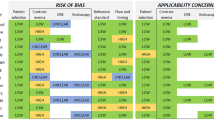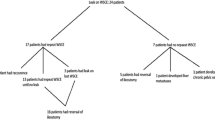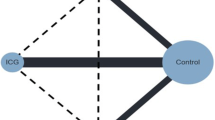Abstract
Purpose
There is no clear consensus on how to assess low rectal anastomotic integrity and patency prior to reversal of de-functioning stoma. The aim of this systematic review was to assess the utility of contrast enema (CE) in this context and to clarify the natural history of radiological leaks.
Methods
Keyword search of electronic databases (Embase, MEDLINE, Cochrane Library, Google Scholar) and bibliographic cross-referencing were performed to identify appropriate studies. Data extraction and synthesis was performed with the primary outcomes being the sensitivity and specificity of CE for detecting clinically significant abnormalities. Statistical analysis was performed using Open Meta-Analyst software. Narrative review of outcomes including those of clinical and radiological leaks was also undertaken.
Results
A total of 1,142 CE from 11 articles were included in the final meta-analysis. CE had high specificity (95.4; 95 % confidence interval = 92.0–97.4) and negative predictive value (98.4; 97.4–99.1) and moderate sensitivity (79.9; 63.9–89.9) and positive predictive value (64.6; 55.5–72.9) for the detection of clinically significant anastomotic problems. There was a high degree of correlation between CE and clinical examination findings (96.7 %). Occult radiological leaks were seen in 5.7 % of CE, and all but one (97 %) eventually underwent successful reversal. Only three quarters of patients with clinical leak underwent successful reversal.
Conclusion
CE is effective at excluding clinically significant anastomotic problems, especially after clinical anastomotic leaks. However, false positive results can be observed in asymptomatic patients, and it is unclear how much additional information CE provides over clinical assessment in the low uncomplicated anastomosis.




Similar content being viewed by others
References
Karanjia ND, Corder AP, Bearn P, Heald RJ (1994) Leakage from stapled low anastomosis after total mesorectal excision for carcinoma of the rectum. Br J Surg 81(8):1224–1226, http://www.ncbi.nlm.nih.gov/pubmed/7953369
Phillips BR, Harris LJ, Maxwell PJ, Isenberg GA, Goldstein SD (2010) Anastomotic leak rate after low anterior resection for rectal cancer after chemoradiation therapy. Am Surg 76(8):869–871, http://www.ncbi.nlm.nih.gov/pubmed/20726419
Lim M, Akhtar S, Sasapu K, Harris K, Burke D, Sagar P, Finan P (2006) Clinical and subclinical leaks after low colorectal anastomosis: a clinical and radiologic study. Dis Colon Rectum 49(10):1611–1619. doi:10.1007/s10350-006-0663-6
Makela JT, Kiviniemi H, Laitinen S (2003) Risk factors for anastomotic leakage after left-sided colorectal resection with rectal anastomosis. Dis Colon Rectum 46(5):653–660. doi:10.1097/01.DCR.0000059328.10563.8C
Hong SY, Kim do Y, Oh SY, Suh KW (2012) Routine barium enema prior to closure of defunctioning ileostomy is not necessary. J Korean Surg Soc 83(2):88–91. doi:10.4174/jkss.2012.83.2.88
Kalady MF, Mantyh CR, Petrofski J, Ludwig KA (2008) Routine contrast imaging of low pelvic anastomosis prior to closure of defunctioning ileostomy: is it necessary? J Gastrointest Surg Off J Soc Surg Aliment Tract 12(7):1227–1231. doi:10.1007/s11605-008-0510-2
Karsten BJ, King JB, Kumar RR (2009) Role of water-soluble enema before takedown of diverting ileostomy for low pelvic anastomosis. Am Surg 75(10):941–944, http://www.ncbi.nlm.nih.gov/pubmed/19886140
Khair G, Alhamarneh O, Avery J, Cast J, Gunn J, Monson JR, Hartley J (2007) Routine use of gastrograffin enema prior to the reversal of a loop ileostomy. Dig Surg 24(5):338–341. doi:10.1159/000107713
Cowan T, Hill AG (2005) Ileostomy closure without contrast study is safe in selected patients. ANZ J Surg 75(4):218–219. doi:10.1111/j.1445-2197.2005.03369.x
Wallace BC, Schmid CH, Lau J, Trikalinos TA (2009) Meta-analyst: software for meta-analysis of binary, continuous and diagnostic data. BMC Med Res Methodol 9:80. doi:10.1186/1471-2288-9-80
DerSimonian R, Laird N (1986) Meta-analysis in clinical trials. Control Clin Trials 7(3):177–188, http://www.ncbi.nlm.nih.gov/pubmed/3802833
Killeen S, Souroullas P, Ho Tin H, Hunter IA, O’Grady H, Gunn J, Hartley JE (2013) Outcomes of asymptomatic anastomotic leaks found on routine postoperative water-soluble enema following anterior resection for cancer. World J Surg 37(11):2700–2704. doi:10.1007/s00268-013-2193-4
Shorthouse AJ, Bartram CI, Eyers AA, Thomson JP (1982) The water soluble contrast enema after rectal anastomosis. Br J Surg 69(12):714–717, http://www.ncbi.nlm.nih.gov/pubmed/7171972
Lee MR, Lee MJ, Kim JH, Hwang Y (2006) Is barium enema prior to ileostomy closure necessary? J Korean Soc Coloproctology 22:298–300
Tang CL, Seow-Choen F (2005) Digital rectal examination compares favourably with conventional water-soluble contrast enema in the assessment of anastomotic healing after low rectal excision: a cohort study. Int J Color Dis 20(3):262–266. doi:10.1007/s00384-004-0652-y
da Silva GM, Wexner SD, Gurland B, Gervaz P, Moon SD, Efron J, Nogueras JJ, Weiss EG, Vernava AM, Zmora O (2004) Is routine pouchogram prior to ileostomy closure in colonic J-pouch really necessary? Colorectal disease. Off J Assoc Coloproctology Great Brit Irel 6(2):117–120, http://www.ncbi.nlm.nih.gov/pubmed/15008910
MacLeod I, Watson AJ, Hampton J, Hussey JK, O’Kelly TJ (2004) Colonic pouchography is not routinely required prior to stoma closure. Color Dis Off J Assoc Coloproctology Great Brit Irel 6(3):162–164. doi:10.1111/j.1463-1318.2004.00626.x
Morris E, Quirke P, Thomas JD, Fairley L, Cottier B, Forman D (2008) Unacceptable variation in abdominoperineal excision rates for rectal cancer: time to intervene? Gut 57(12):1690–1697. doi:10.1136/gut.2007.137877
Codd RJ, Evans MD, Davies M, Harris DA, Chandrasekaran TV, Khot UP, Morgan AR, Beynon J (2014) Permanent stoma rates: a misleading marker of quality in rectal cancer surgery. Colorectal disease : Off J Assoc Coloproctology Great Brit Irel 16(4):276–280. doi:10.1111/codi.12509
Nabi H, Morgan M, Ooi K, Turner C, Kozman D (2013) The routine use of contrast enemas performed prior to the reversal of loop ileostomies does affect management. World J Colorectal Surg 3(4)
Palmisano S, Piccinni G, Casagranda B, Balani A, de Manzini N (2011) The reversal of a protective stoma is feasible before the complete healing of a colorectal anastomotic leak. Am Surg 77(12):1619–1623, http://www.ncbi.nlm.nih.gov/pubmed/22273219
Conflict of interest
None
Author information
Authors and Affiliations
Corresponding author
Electronic supplementary material
Below is the link to the electronic supplementary material.
Supplementary Fig. 5
This forest plot represents the cumulative sensitivity of contrast enema for detecting clinically significant anastomotic leak. Size of the solid boxes represents weight of each individual study and the bars represent 95 % confidence interval. The blue diamond at the bottom of the plot on the left represents cumulative sensitivity with the edges of the diamond representing 95 % confidence interval. Estimates and plot on the right represents contribution of individual studies to the cumulative sensitivity estimate. CI—Confidence interval, TP—True positive, FN—False negative. (GIF 3 kb)
Supplementary Fig. 6
This forest plot represents the cumulative specificity of contrast enema for detecting clinically significant anastomotic leak. Size of the solid boxes represents weight of each individual study and the bars represent 95 % confidence interval. The blue diamond at the bottom of the plot on the left represents cumulative specificity with the edges of the diamond representing 95 % confidence interval. Estimates and plot on the right represents contribution of individual studies to the cumulative specificity estimate. CI—Confidence interval, TN—True negative, FP—False positive. (GIF 3 kb)
Supplementary Fig. 7
This forest plot represents the cumulative sensitivity of contrast enema for detecting clinically significant anastomotic stricture. Size of the solid boxes represents weight of each individual study and the bars represent 95 % confidence interval. The blue diamond at the bottom of the plot on the left represents cumulative sensitivity with the edges of the diamond representing 95 % confidence interval. Estimates and plot on the right represents contribution of individual studies to the cumulative sensitivity estimate. CI—Confidence interval, TP—True positive, FN—False negative. (GIF 3 kb)
Supplementary Fig. 8
This forest plot represents the cumulative specificity of contrast enema for detecting clinically significant anastomotic stricture. Size of the solid boxes represents weight of each individual study and the bars represent 95 % confidence interval. The blue diamond at the bottom of the plot on the left represents cumulative specificity with the edges of the diamond representing 95 % confidence interval. Estimates and plot on the right represents contribution of individual studies to the cumulative specificity estimate. CI—Confidence interval, TN—True negative, FP—False positive. (GIF 3 kb)
Rights and permissions
About this article
Cite this article
Habib, K., Gupta, A., White, D. et al. Utility of contrast enema to assess anastomotic integrity and the natural history of radiological leaks after low rectal surgery: systematic review and meta-analysis. Int J Colorectal Dis 30, 1007–1014 (2015). https://doi.org/10.1007/s00384-015-2225-7
Accepted:
Published:
Issue Date:
DOI: https://doi.org/10.1007/s00384-015-2225-7




